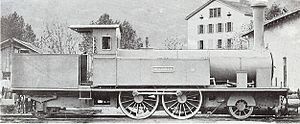VSB B 2/3
| VSB B 2/3 | |
|---|---|
|
VSB B 2/3 No. 46
|
|
| Numbering: | VSB 45-46 SBB 1071-1072 |
| Number: | 2 |
| Manufacturer: | VSB |
| Year of construction (s): | 1876 |
| Retirement: | 1904-05 |
| Axis formula : | 1'B |
| Gauge : | 1435 mm ( standard gauge ) |
| Length over buffers: | 11,588 mm |
| Service mass: | 48 t |
| Top speed: | 75 km / h |
| Indexed performance : | 441 kW |
| Starting tractive effort: | 35.8 kN |
| Driving wheel diameter: | 1,590 mm |
| Cylinder diameter: | 408 mm |
| Piston stroke: | 580 mm |
| Boiler overpressure: | 10 bar 12 bar 1 |
| Grate area: | 1.4 m² |
| Superheater area : | no |
| Evaporation heating surface: | 130.2 m³ |
| Brake: |
External brake damp spring brake from 1892 Westinghouse brake |
| 1 2nd boiler | |
In 1876, the United Swiss Railways (VSB) purchased two steam locomotives for passenger trains with tenders of the type B 2/3 . At first they had the series designation II, from 1887 to 1902 they were designated as B2T.
The two locomotives were built by the machine inspector Klose in his own workshop in Rorschach with the help of new boilers from the Saxon machine factory in Chemnitz. The purchase price for each machine was 53,000 Swiss Francs.
Technical
Since the Engerth locomotives Ec 2/5 were converted to C 3/3 at the same time , a number of components were used. It was made in an overhanging design, that is, all axes are in front of the fire box. The single-axle tender is connected to the locomotive by means of a spherical pivot pin. In order to increase the maneuverability in curves, the running axle was built into a special transverse frame, which was connected to the tender by means of angle levers and tie rods, this type of construction is called unstable connection according to the Klosse system . The machine had a total wheelbase (without tender) of 4025 mm. The boiler, which was installed 1980 mm above the upper edge of the rail, had a steam dome with a Klose type safety valve. The slide regulators were built into it. The inner frame was supported by six drive axle springs. These were arranged above the frame. Under the frame there were still two clutch springs that served as compensation levers for the drive axles. The clutch springs were loaded by means of a one-armed lever. The springs of the barrel axle and the tender stood over the bearings. The two water tanks were located on the side of the boiler to increase the friction weight. They were connected by flexible pipes to the auxiliary water tank under the coal tank of the tender. The steam engine was located between the frame, had horizontal cylinders and was equipped with an all-control system that operated on a valve located in the common central valve body. Since the outer coupling rods ran towards the inner drive rods, the inertial forces were approximately balanced. The sandpit was on the front of the walking board. A Klose speedometer was installed. The four-block tender brake was designed as an external brake (hand brake). The locomotive itself was equipped with a Klose type steam spring brake. Around 1892 an automatic Westinghouse brake was installed, which also acted on the drive axle in four blocks. The air tank was mounted on the left water tank.
| VSB number |
SBB number |
Surname | Factory number |
Construction year | 2nd boiler | Out of service |
|---|---|---|---|---|---|---|
| 45 | 1071 | Septimer | 4th | 1876 | - | 1905 |
| 46 | 1072 | Maloia | 5 | 1876 | 1896 | 1904 |
Operational
They were all assigned to the Rorschach workshop and thus also to SBB District IV.
Both machines were scrapped.
swell
- Alfred Moser: The steam operation of the Swiss railways 1847–1966 , p. 120ff.
Remarks
- ↑ The VSB, the two designated Tender machine incorrectly as tank engines .
